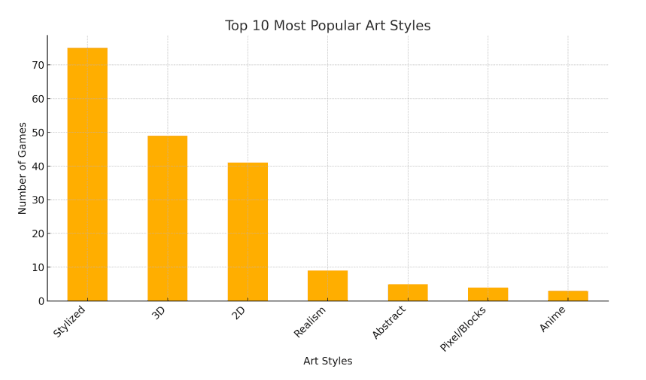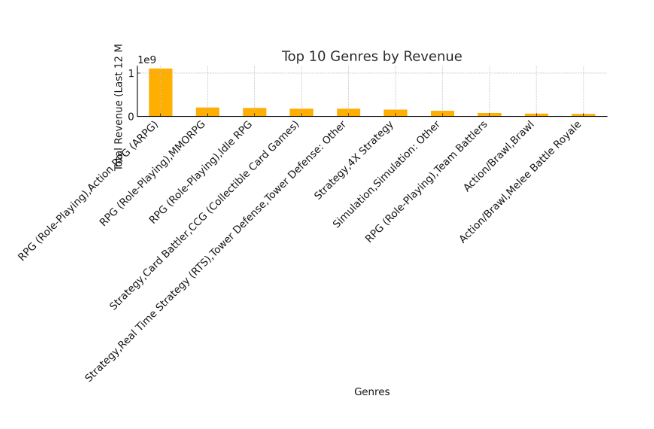Analyzing Trends in the Top 100 New Mobile Games in 2024

The mobile gaming landscape is as dynamic as it is competitive. By analyzing data from the top 100 new games in 2024, this blog aims to uncover actionable insights into game design, art styles, settings, marketing strategies, and monetization models that made these games work. Here's a breakdown of the findings and what they mean for game developers.
The data below is for the period of 2024 till December 8, 2024, and is based on the top 100 new games released with the highest downloads and jump in rankings.
Top 10 Most Popular Game Genres

When it comes to genre popularity, Puzzle games lead the way with 32 titles in the top 100. Their simple mechanics and universal appeal make them accessible to a broad audience. Arcade and Simulation games, each with 17 entries, cater to players seeking quick, engaging gameplay loops, while Racing games (10 entries) appeal to adrenaline junkies with competitive spirits.
Other notable mentions include:
Sort Puzzle (7 games): A subgenre offering unique challenges.
RPG (6 games): Immersive worlds with character progression.
Sandbox (6 games): Open-ended creativity for players to explore.
Key Insight:
Puzzle games dominated due to their accessibility and wide audience appeal, with Arcade and Simulation games offering complementary fast-paced or immersive experiences.
Top 10 Most Successful Publishers
The top publishers in the mobile gaming space reveal a mix of industry titans and up-and-comers

iKame Games - Zego Studio (5 games): Led charge with a strong portfolio of popular titles.
VOODOO (3 games): Renowned for leveraging data-driven marketing to scale their games.
Kiwi Fun and Bravestars Publishing (2 games each): Highlight the competitive and diverse nature of successful developers/publishers.
Key Insight:
The success of publishers is often tied to robust marketing strategies, regular updates, and community-building efforts, which ensure sustained player engagement.
Top 10 Most Popular Art Styles
Art styles play a pivotal role in shaping the identity of a game:
Stylized (75 games): A clear favorite for its visual appeal and compatibility across devices.
3D (49 games) and 2D (41 games): Both formats cater to diverse gameplay mechanics.
Other notable styles include Realism (9 games) and Abstract (5 games).

Key Takeaway
Stylized art dominates due to its ability to balance creativity and technical feasibility, while 3D and 2D visuals remain popular for their gameplay versatility.
Patterns in the Top 4 Genres
A closer look at the leading genres reveals consistent patterns in art styles and settings:
Art Styles

Stylized visuals (57 games) dominate across genres, reflecting their broad appeal.
3D (37 games) and 2D (34 games) are nearly equally popular, showing versatility in gameplay mechanics.
In settings, Real Life (6 games) is the most common, while Fantasy and Fairy Tale (2 games each) add a touch of wonder.
Settings

Key Takeaway
Stylized visuals and Real-Life settings dominate the top genres, while Fantasy elements add a touch of escapism.
Top 10 Game Genres by Revenue

RPG (Role-Playing), Action RPG (ARPG): $1,112,409,937
RPG (Role-Playing), MMORPG: $205,759,345
RPG (Role-Playing), Idle RPG: $186,923,052
Strategy, Card Battler, CCG (Collectible Card Games): $175,175,015
Strategy, Real-Time Strategy (RTS), Tower Defense: $173,981,621
Strategy, 4X Strategy: $155,001,406
Simulation, Simulation: Other: $125,567,171
RPG (Role-Playing), Team Battlers: $74,770,837
Action/Brawl, Brawl: $60,375,771
Action/Brawl, Melee Battle Royale: $51,836,466
When it comes to profitability, RPGs dominate, with Action RPGs (ARPGs) generating over $1.1 billion in revenue. Subgenres like MMORPGs ($205M) and Idle RPGs ($186M) also perform strongly, emphasizing the enduring appeal of character progression and immersive storytelling.
Strategy games are another powerhouse, with:
Card Battlers ($175M) and Tower Defense ($174M) showcasing their engagement and monetization potential.
Simulation ($125M) and Brawl subgenres ($60M), though lower in revenue, contribute significantly to a balanced genre portfolio.
Key Insight:
RPGs and Strategy games lead revenue generation, thanks to their ability to deeply engage players, while Simulation and Brawl games demonstrate consistent profitability across smaller audiences.
Overall Trends in Game Design, Marketing, and Monetization
Certain patterns in game design, marketing, and monetization are emerging as key drivers of success. Let’s explore these trends in greater depth to understand what makes top-performing games stand out.
Game Design Patterns: Blending Simplicity with Appeal
One of the most striking trends in game design is the dominance of stylized visuals. These designs are not only visually appealing but also accessible across a wide range of devices, ensuring games reach the broadest audience possible. Players are drawn to games that look polished and engaging, and stylized art delivers just that.
In terms of gameplay mechanics, simplicity reigns supreme. Casual gamers, who make up a large portion of the market, prefer intuitive controls that allow them to jump right into the action without a steep learning curve. This explains the enduring popularity of genres like Puzzle and Arcade, which cater to diverse audiences with easy-to-understand mechanics and mass-market appeal.
Marketing Approaches: Targeted, Interactive, and Continuous
The marketing strategies behind these games reveal a sophisticated use of technology and community-building efforts. Data-driven user acquisition (UA) is a cornerstone for publishers like VOODOO, who leverage targeted advertising on social media and app stores to precisely reach their audience. This approach ensures that marketing dollars are spent efficiently while bringing in high-value players.
Another critical factor is community engagement. Social media platforms play a pivotal role, with publishers creating buzz through teaser campaigns, fan art contests, and user-generated content. This not only drives engagement but also fosters a loyal player base.
Lastly, successful games prioritize frequent updates to keep players coming back. Whether it’s seasonal events, new levels, or fresh themes, these updates keep the gameplay experience dynamic and exciting, ensuring players remain invested over the long term.
Monetization Models: Balancing Accessibility and Revenue
Mobile games have mastered the art of making their content both accessible and profitable. The freemium model remains the most popular approach, offering games for free while generating revenue through in-app purchases for power-ups, skins, or ad-free experiences. This model caters to a wide audience while allowing players to spend at their comfort level.
Ads, particularly interstitial and rewarded formats, dominate casual games. They serve as a reliable revenue stream while giving non-paying players the option to engage with ads in exchange for in-game rewards. Meanwhile, subscription services are emerging as a popular choice in genres like Simulation and RPG, offering exclusive perks for dedicated players.
Actionable Recommendations for Game Developers
Based on these trends, here are some practical steps for developers aiming to create successful games:
Embrace Stylized Art: Focus on visually stunning yet accessible designs that perform well in both 3D and 2D formats. This can appeal to a broader audience and enhance the game’s visual identity.
Leverage Relatable Settings: Combining Real-Life scenarios with elements of Fantasy can create an engaging balance of familiarity and escapism, appealing to players across different demographics.
Optimize User Acquisition: Use data-driven advertising strategies and collaborate with influencers for authentic endorsements. Experiment with A/B testing to refine campaigns and improve conversion rates.
Adopt Freemium Models Thoughtfully: Incorporate non-intrusive ads and strategically designed in-app purchases to maximize revenue without alienating your player base.
Build an Engaged Community: Platforms like Discord or Instagram can help you foster loyalty through interactive campaigns, sneak peeks, and contests.
Looking Ahead: What’s Next for Mobile Gaming?
The future of mobile gaming looks both exciting and innovative, with trends that promise to reshape the landscape:
AI Integration: Expect more games to use AI for personalization, creating adaptive experiences tailored to individual player preferences.
Hyper-Casual Dominance: Games with minimalist designs and quick gameplay loops are likely to continue thriving, particularly in the mobile space.
Cross-Platform Play: Seamless transitions between mobile, PC, and consoles will become increasingly important, offering players the flexibility to enjoy their favorite games anywhere.
AI Analytics: As seen with top publishers, data plays a pivotal role in optimizing game metrics and user acquisition. Here’s exactly where a tool such as Segwise.ai comes in handy to boost ROAS for mobile games with its AI Copilot. With AI monitoring of your campaigns you can ensure that your budgets are spent in the most effective way possible. Additionally, it’s creative analysis tools allows you to identify trends amongst your creatives on a granular level, which yet again allows you to spend efficiently and act faster to optimize your ROAS.
Wrapping It All Up
So, what does all this mean? If you’re dreaming of creating the next big hit in mobile gaming, here’s the TL;DR: It’s all about keeping things simple, stylish, and smart. Players love intuitive gameplay (think Puzzle games for the win), eye-catching visuals (hello, Stylized art!), and relatable or fantastical settings that let them escape - or connect.
But it’s not just about the game itself. Success in this competitive space also comes down to data-driven marketing (knowing your players better than they know themselves), frequent updates (give them new stuff to love), and smart monetization models (freemium is still king).
And don’t forget - with trends like AI personalization, hyper-casual designs, and cross-platform gaming on the rise, staying ahead of the curve isn’t optional; it’s survival. So, whether you’re a developer, publisher, or marketer, keep these insights in your back pocket, because the games that will win in 2025 are being shaped by the decisions you make today.
Make it fun, make it fresh, and make it stick.

Comments
Your comment has been submitted successfully!